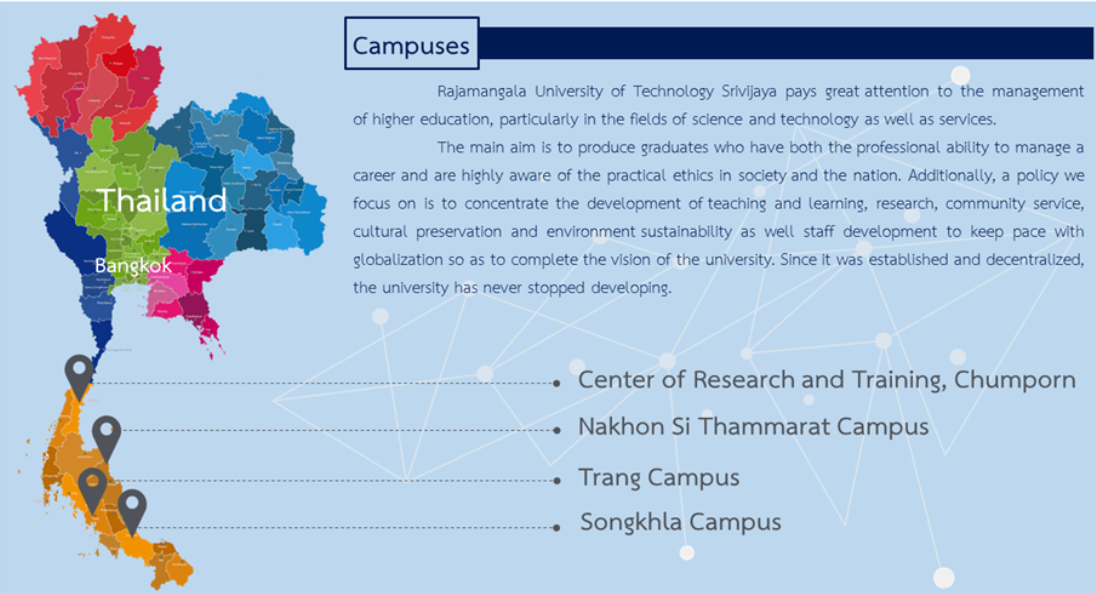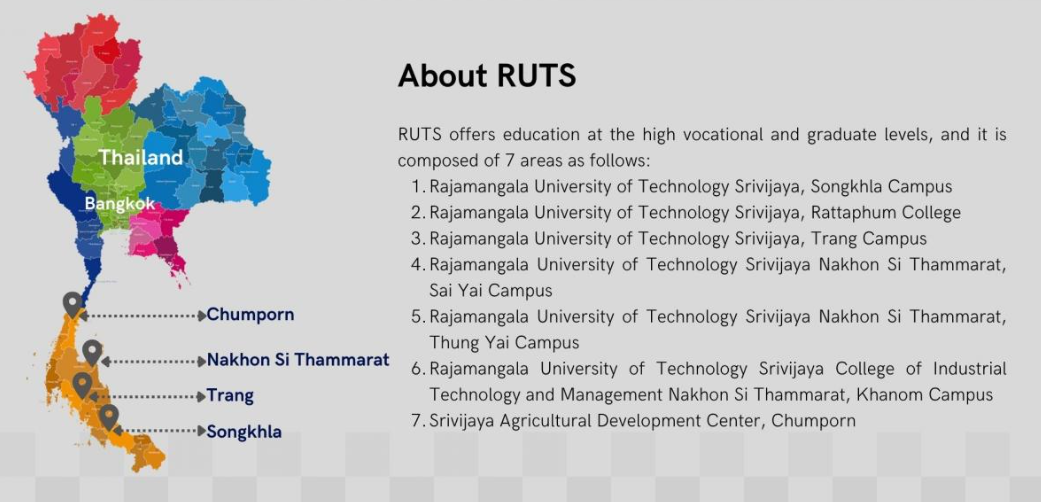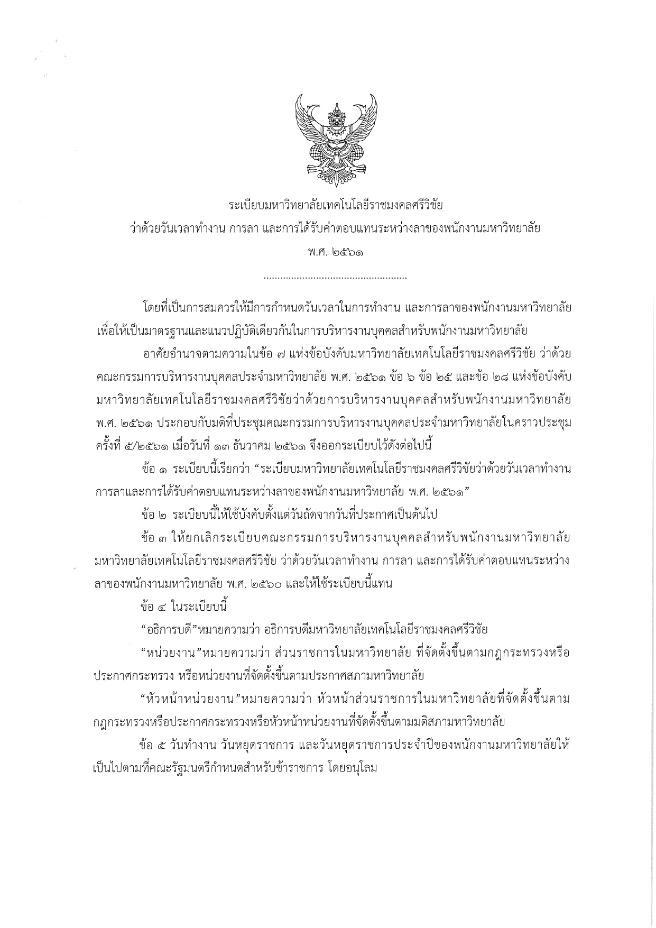Reporters: Assoc. Prof. Dr. Chatree Homkhiew, Assist. Prof. Dr. Thanwit Naemsai, Assist.Prof.Dr. Thanakorn Damsud , Assist.Prof.Dr.Kosin Teeparuksapun
Evidence Date: Jan-Dec 2023
Related SDGs:

Details:
Rajamangala University of Technology Srivijaya (RUTS) located in southern Thailand. It is a prominent institution within the Rajamangala University of Technology (RMUT) consortium. RUTS prioritizes the efficient management of higher education, particularly in the fields of science, technology, and services. The principal objectives are to develop graduates who have the necessary professional skills for successful professions and a deep understanding of their ethical duties in society and the nation. Moreover, RUTS has instituted policies that emphasize the enhancement of research, pedagogy, community engagement, cultural conservation, environmental sustainability, and the continuous professional development of its personnel to ensure conformity with the exigencies of a globalized society and the achievement of the university’s aspirational objectives.
As shown in Figure 1, RUTS provides education at the advanced vocational and graduate levels. The institution is divided into four sites across the country. In addition to this, it offers education at the graduate and high vocational levels, offering instruction in seven different subject areas (Figure 2).

Figure 1. RUTS campus

Figure 2. Area of high vocational and graduated levels education of RUTS
Rajamangala University of Technology Srivijaya (RUTS) boasts a diverse and extensive academic structure, comprising a total of 12 faculties and 2 colleges. These faculties and Colleges serve as the foundational units within the university, each specializing in distinct academic areas and fields of study. The total number of employees of RUTS is 1405.
Related Indicator: Indicator 9.4.2.4 Number of academic staffs
RUTS is supported by a dedicated team of 748 academic personnel that are integral to the university’s educational structure. These educators and professionals substantially contribute by providing direction, instruction, and knowledge to students in various fields.
Related Indicator: Indicator 9.4.2.1 Number of academic staffs by subject area: STEM
The academic staff distribution in STEM fields (science, technology, engineering, and mathematics) comprises 495 dedicated members. These professionals bring a diverse range of expertise and knowledge, supporting the university’s mission to advance education and research in critical areas such as science, technology, engineering, and mathematics. Their contributions are vital in fostering innovation, driving academic excellence, and equipping students with the skills needed to succeed in these rapidly evolving fields.
Related Indicator: Indicator 9.4.2.2 Number of academic staffs by subject area: Medicine
The distribution of academic staff members in the field of medicine consists of 43 dedicated professionals. These experts play a crucial role in shaping the educational and research environment within the university’s medical programs. They provide specialized knowledge, clinical experience, and mentorship to students, helping to prepare the next generation of healthcare professionals. Their contributions are essential in advancing medical education, research, and the overall quality of healthcare training at the institution.
Related Indicator: Indicator 9.4.2.3 Number of academic staffs by subject area: Arts and humanities/Social Sciences
The allocation of academic personnel in the domains of arts and humanities, including social sciences, comprises 240 committed professionals. These educators and scholars contribute extensive knowledge and skill to their fields, significantly enhancing critical thinking, creativity, and comprehension of human society and culture. They contribute to several academic programs, including literature, history, philosophy, sociology, and psychology, through their teaching, research, and mentorship. Their endeavors foster well-rounded graduates endowed with analytical skills, cultural knowledge, and the capacity to tackle intricate societal challenges. Table 1 summarizes the number of RUTS academic staff members by faculties/colleges.
Table 1. Number of RUTS academic staff by faculties/colleges.
|
Faculty & College |
STEM |
Medicine |
Art & Humanities/Social Science |
|---|---|---|---|
|
Faculty of Science and Fisheries Technology |
55 |
– |
– |
|
Faculty of Engineering and Technology |
26 |
– |
– |
|
College of Hospitality of Tourism |
– |
– |
29 |
|
Faculty of Agriculture |
32 |
5 |
– |
|
Faculty of Agro-industry |
13 |
– |
– |
|
Faculty of Veterinary Medicine |
– |
38 |
– |
|
Faculty of Science and Technology |
63 |
22 | |
|
Faculty of Management Technology |
12 |
41 | |
|
College of Industrial Technology |
27 |
– |
18 |
|
Faculty of Business Administration |
12 |
41 | |
|
Faculty of Engineering |
108 |
– |
– |
|
Faculty of Liberal Arts |
42 |
– |
50 |
|
Faculty of Architecture |
31 |
9 | |
|
Faculty of Industrial Education and Technology |
43 |
– | |
|
Rattaphum College |
31 |
– |
– |
|
Total |
495 |
43 |
240 |
|
748 | |||
Table 2 summarizes the academic ranks of personnel across diverse faculties and colleges. RUTS categorizes its academic staff into four classifications: lecturers, assistant professors, associate professors, and professors.
Table 2. Academic ranks, of RUTS academic staffs.
|
Academic ranks |
Number of staffs |
|---|---|
|
Lecturers |
381 |
|
Assistant professors |
335 |
|
Associate professors |
31 |
|
Professor |
1 |
|
748 |
Related Links: https://personnel.rmutsv.ac.th/ruts/




